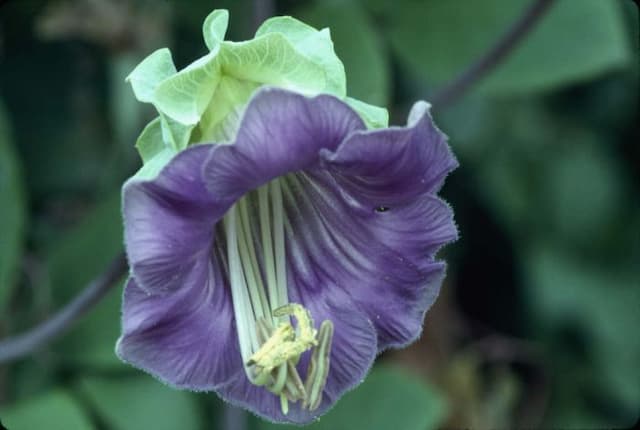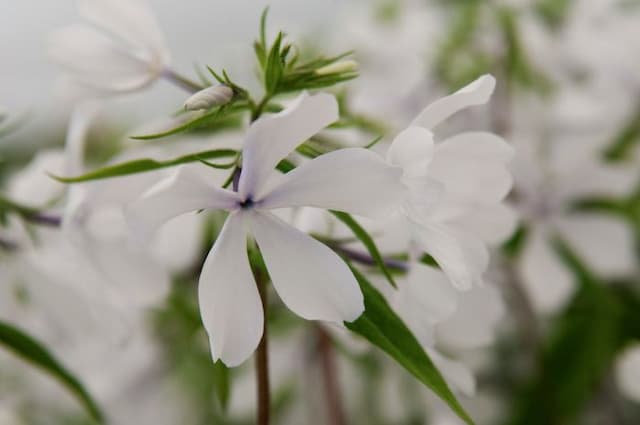Meadow phlox Phlox maculata 'Rosalinde'

ABOUT
Phlox maculata 'Rosalinde' is a perennial plant that features eye-catching clusters of fragrant flowers. These blooms possess a soft, enchanting pink hue with a distinct, darker pink eye at the center. The flowers are small yet abundant, forming dense, pyramidal-shaped flower heads that deliver a striking display atop upright stems. The plant's stems are spotted, lending it a distinctive characteristic and adding to its charm. The foliage comprises lance-shaped, medium-green leaves that provide a lush backdrop for the floral show. These leaves are arranged in a manner that creates a full, bushy appearance, contributing to the plant's visual appeal. The foliage is sometimes characterized by faint variegation or streaking, which adds subtle textural interest to the overall look of the plant. As with other members of its genus, 'Rosalinde' emits a delightful scent that becomes more pronounced on warm, summer evenings, attracting pollinators such as hummingbirds and butterflies to the garden. Delicate and charming, this plant adds both visual splendor and aromatic allure to any garden setting. With proper care, it can return for several seasons, becoming a reliable and enchanting component of the landscape.
About this plant
 Names
NamesSynonyms
Meadow Phlox, Wild Sweet William, Spotted Phlox.
Common names
Phlox maculata 'Rosalinde'.
 Toxicity
ToxicityTo humans
Meadow phlox, generally known as Phlox maculata 'Rosalinde', is not considered highly toxic to humans. However, as with many plants, it can cause mild gastrointestinal disturbances if ingested in large quantities. Symptoms may include nausea, vomiting, or diarrhea. It is always advisable to avoid eating any part of ornamental plants due to potential adverse reactions or the presence of harmful substances. If ingestion occurs and symptoms arise, seek medical advice.
To pets
Meadow phlox, or Phlox maculata 'Rosalinde', is not known to be highly toxic to pets such as dogs and cats. While the plant is not typically associated with severe toxicity, ingestion of plant material might cause mild gastrointestinal upset in some pets. Symptoms could include vomiting or diarrhea if ingested in significant amounts. As each pet may react differently to various plants, it is best to avoid allowing pets to consume ornamental plants, and if your pet does ingest meadow phlox and displays adverse symptoms, consult with your veterinarian.
 Characteristics
CharacteristicsLife cycle
Perennials
Foliage type
Deciduous
Color of leaves
Green
Flower color
Pink
Height
2-3 feet (0.6-0.9 meters)
Spread
1-2 feet (0.3-0.6 meters)
Plant type
Herb
Hardiness zones
4
Native area
Eastern North America
Benefits
 General Benefits
General Benefits- Attracts Pollinators: Phlox maculata 'Rosalinde' provides nectar and pollen for bees, butterflies, and other beneficial insects, promoting biodiversity in the garden.
- Long Blooming: This cultivar has a lengthy flowering period spanning several weeks, offering enduring visual appeal.
- Ease of Care: Meadow phlox is generally easy to grow and maintain, thriving in a range of garden settings with minimal care.
- Disease Resistance: 'Rosalinde' has improved resistance to powdery mildew, which is a common problem in many phlox species.
- Aesthetic Appeal: Its pink-striped flowers add a unique and striking visual element to landscapes and flower arrangements.
- Fragrance: The blooms emit a delightful fragrance that can enhance the sensory experience of a garden.
- Cottage Garden Charm: Meadow phlox is ideal for achieving a classic cottage garden look due to its height and profuse flowering.
- Wildlife Habitat: It provides cover and nesting opportunities for small wildlife, contributing to the creation of a wildlife-friendly garden.
- Mix and Match Potential: This plant can be easily combined with other perennials to create diverse and attractive garden designs.
- Seasonal Interest: In addition to summer blooms, meadow phlox provides visual interest with its foliage in spring and fall.
 Medical Properties
Medical PropertiesThis plant is not used for medical purposes.
 Air-purifying Qualities
Air-purifying QualitiesThis plant is not specifically known for air purifying qualities.
 Other Uses
Other Uses- Phlox can be used in eco-friendly dye making, with different parts of the plant yielding various colors for natural fabric dyes.
- Garden phlox is occasionally utilized in perfumery for its sweet, floral scent that can contribute to complex fragrance profiles.
- The plant’s dense growth habit makes it suitable for use in creating living garden borders or edges to define different areas of a landscape.
- Garden phlox, when dried, can be a component of potpourri mixes, adding a visual element and a mild fragrance to the mixture.
- When planted in mass, garden phlox can serve as a ground cover to help control erosion on sloped landscapes.
- Garden phlox can be used as a food source for butterflies, acting as a natural way to attract pollinators to a garden or habitat strategy.
- In flower language and symbolism, garden phlox can be gifted to convey the message of unity or sweet dreams, reflecting old traditions.
- The sturdy stems of garden phlox are sometimes used in botanical crafts, like handmade papers or natural weavings.
- You can use the vibrant colors of garden phlox in garden design to create visually stunning patterns and mosaics in flower beds.
- Garden phlox plants can be used as a natural classroom, teaching children about plant growth, pollination, and the lifecycle of a perennial.
Interesting Facts
 Feng Shui
Feng ShuiThe Meadow Phlox is not used in Feng Shui practice.
 Zodiac Sign Compitability
Zodiac Sign CompitabilityThe Meadow Phlox is not used in astrology practice.
 Plant Symbolism
Plant Symbolism- Harmony - The phlox is often associated with the idea of harmony due to its clusters of flowers that grow closely together, representing unity and balance.
- Unity - Like harmony, the unity of its blossoms symbolizes the coming together of people or ideas to form a whole.
- Proposal - In Victorian flower language, giving a bouquet of phlox was a way to propose marriage or suggest a romantic relationship.
- Sweet Dreams - Phlox is also said to symbolize sweet dreams, thus sometimes used in bouquets or bedroom arrangements to encourage pleasant sleep.
- Partnership - The interconnected growth pattern of phlox suggests a strong partnership, a network of support, often reflecting human relationships.
 Water
WaterMeadow phlox should be watered deeply enough to saturate the root zone, approximately to a depth of an inch into the soil which typically means about 1 gallon per plant for established plants. During the growing season, ensure a consistent watering schedule, watering meadow phlox once or twice a week depending on weather conditions, with less frequent watering required during cooler, rainy periods and more during hot, dry spells. It's crucial to avoid overwatering as this can lead to root rot; the soil should be allowed to dry out slightly between waterings. For container-grown plants, water until it runs out of the drainage holes and then allow the soil to dry out somewhat before watering again.
 Light
LightMeadow phlox thrives best in full sun but can tolerate partial shade, especially in the afternoon. Ensure it receives at least 6 hours of direct sunlight daily for optimal growth and flowering. An ideal spot would be one where the plant gets morning sunlight and some protection from the intense heat of late afternoon sun, particularly in hotter climates.
 Temperature
TemperatureMeadow phlox is hardy in USDA zones 4 to 8, capable of withstanding minimum temperatures down to -30°F, and maximum temperatures well into the 90s°F. The ideal growing temperature for meadow phlox ranges between 68°F and 85°F. Sudden frosts below the survival range can be damaging, so providing some protection if unexpected cold snaps occur is beneficial.
 Pruning
PruningMeadow phlox benefits from pruning to promote vigorous, healthy growth and to maintain a tidy appearance. Deadheading spent flowers can encourage further blooming during the season. Cut back the foliage after frost has killed the leaves in late fall or early winter as part of winter preparation. Pruning can also include thinning out stems in early spring to improve air circulation, which helps to prevent disease.
 Cleaning
CleaningAs needed
 Soil
SoilWild Sweet William (Phlox maculata 'Rosalinde') thrives in a soil mix that's rich in organic matter, moist but well-draining, with a pH of around 6.5 to 7.0. A mixture of garden soil, compost, and a bit of sand or perlite to improve drainage creates an ideal environment for this perennial.
 Repotting
RepottingWild Sweet William does not typically require frequent repotting as it is generally cultivated in gardens rather than containers. However, if grown in pots, repotting every 2-3 years or when the plant outgrows its container can help maintain its health.
 Humidity & Misting
Humidity & MistingWild Sweet William prefers a moderate humidity level, typical of outdoor garden environments, and does not require specific humidity adjustments as it is quite adaptable and hardy in a range of conditions.
 Suitable locations
Suitable locationsIndoor
Provide bright light, moist soil, and good air flow.
Outdoor
Plant in sun to partial shade, enrich soil, mulch, and water.
Hardiness zone
4-8 USDA
 Life cycle
Life cyclePhlox maculata 'Rosalinde', commonly known as Meadow Phlox or Wild Sweet William, begins its life as a seed, which when sown and subjected to favourable conditions of moisture and temperature, will germinate. The seedling stage follows, marked by the emergence of the primary root and cotyledons, which then develop true leaves, enabling photosynthesis. As it transitions into the vegetative stage, Meadow Phlox develops a robust root system and lush foliage, during which time it also undergoes considerable stem and leaf growth. The plant then enters the flowering stage, usually in the early summer, revealing clusters of pink to purple aromatic blossoms that attract pollinators such as bees and butterflies. After pollination, the flowers produce seed capsules that mature, eventually releasing seeds for the next generation. Finally, Meadow Phlox may enter dormancy during the winter, particularly in colder climates, before resuming growth in the spring.
 Propogation
PropogationPropogation time
Spring to early summer
The most popular method for propagating Phlox maculata 'Rosalinde', commonly known as Meadow Phlox, is by division. Division is typically performed in early spring or autumn. To propagate by division, carefully dig up an established Meadow Phlox plant, ensuring that you keep a generous amount of soil around the roots. Then, using a sharp spade or knife, divide the plant into smaller sections, each with several shoots and a portion of the root system. Replant the divisions at the same depth as the original plant and water them thoroughly. This method allows gardeners to quickly and effectively multiply their Meadow Phlox while ensuring the new plants are true to the characteristics of the parent plant.









